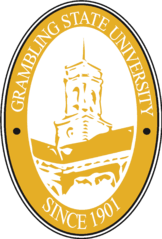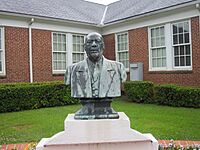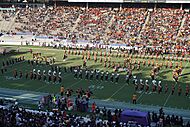Grambling State University facts for kids
 |
|
|
Former name
|
Colored Industrial and Agricultural School (1901–1905) North Louisiana Agricultural and Industrial School (1905–1928) Louisiana Negro Normal and Industrial Institute (1928–1946) Grambling College (1946–1974) |
|---|---|
| Motto | Where Everybody Is Somebody |
| Type | Public historically Black university |
| Established | 1901 |
|
Parent institution
|
UL System |
|
Academic affiliations
|
Space-grant |
| Endowment | $7 million |
| President | Martin Lemelle |
| Provost | Connie Walton |
| Students | 5,232 |
| Location |
,
,
United States
32°31′31″N 92°42′55″W / 32.5252°N 92.7153°W |
| Campus | Rural |
| Newspaper | The Gramblinite |
| Colors | Black & Gold |
| Nickname | Tigers |
|
Sporting affiliations
|
NCAA Division I FCS – SWAC |
 |
|
Grambling State University (GSU, Grambling, or Grambling State) is a public historically black university in Grambling, Louisiana. Grambling State is home of the Eddie G. Robinson Museum and is listed on the Louisiana African American Heritage Trail. Grambling State is a member-school of the University of Louisiana System and Thurgood Marshall College Fund.
Grambling State's athletic teams compete in Division I of the National Collegiate Athletic Association and are known as the Grambling State Tigers. Grambling State is a member of the Southwestern Athletic Conference.
Contents
History
Grambling State University developed from the desire of African-American farmers in rural north Louisiana who wanted to educate other African Americans. In 1896, the North Louisiana Colored Agriculture Relief Association led by Lafayette Richmond was formed to organize and operate a school. After opening a small school west of what is now the town of Grambling, the Association requested assistance from Booker T. Washington of Tuskegee Institute in Alabama. Charles P. Adams, sent to aid the group in organizing an industrial school, became its founder and first president.
Under Adams' leadership, the Colored Industrial and Agricultural School opened on November 1, 1901. Four years later, the school moved to its present location and was renamed as the North Louisiana Agricultural and Industrial School. By 1928, the school was able to offer two-year professional certificates and diplomas after becoming a state junior college. The school was renamed Louisiana Negro Normal and Industrial Institute.
In 1936, the program was reorganized to emphasize rural education. It became known as "The Louisiana Plan" or "A Venture in Rural Teacher Education." Professional teaching certificates were awarded when a third year was added in 1936, and the first baccalaureate degree was awarded in 1944 in elementary education. The institution's name was changed to Grambling College in 1946 in honor of a white sawmill owner, P. G. Grambling, who donated a parcel of land for the school. Thereafter, the college prepared secondary teachers and added curricula in sciences, liberal arts and business. With these programs in effect, the school was transformed from a single purpose institution of teacher education into a multi-purpose college.
In 1949, the college was accredited by the Southern Association of Colleges and Schools (SACS). The Grambling science building is one of twenty-six public structures in Louisiana constructed by the prominent contractor George A. Caldwell. In 1974, the addition of graduate programs in education allowed the college to be granted university status under its present name, Grambling State University.
From 1977 to 2000, the university grew and prospered. Several new academic programs were incorporated. New facilities were added to the 384-acre (1.55 km2) campus, including a business and computer science building, school of nursing, student services building, stadium, stadium support facility, and an intramural sports center.
In May 1999, President Clinton served as the commencement keynote speaker.
State Representative George B. Holstead of Ruston worked to increase state appropriations for Grambling State University during his legislative tenure from 1964 to 1980.
On December 7, 2010, the Grambling State University Historic District, an area comprising 16 buildings dating from 1939 to 1960, was added to the National Register of Historic Places.
In 2019, Grambling broke ground for building of the first digital library on a HBCU campus. The $16.6 million project was completed in 2023.
Presidents
- Charles P. Adams (1901-1936)
- Ralph Waldo Emerson Jones (1936-1977)
- Joseph Benjamin Johnson
- Harold W. Lundy
- Raymond Hicks
- Leonard Haynes III
- Steve A. Favors (until 2001)
- Neari Francois Warner was the university's first female president.
- Horace Judson (2004- October 2009) - led a 5-year campaign to rebuild the institution's facilities.
- Frank Pogue (2009-June 2014) - started as the institution's eighth president
- Cynthia S. Warrick (2014-2015) - became Grambling's second female president
- Willie Larkin (2015-2016)
- Richard J. Gallot, Jr. (2016-2024) - GSU alumnus that served as the tenth president
- Martin Lemelle - the current and 11th president is a GSU alumnus
Academics
|
|
Grambling State University offers undergraduate and graduate degrees through the following four colleges:
- College of Art & Sciences
- College of Business
- College of Educational and Graduate Studies
- College of Professional Studies
Grambling State offers its only doctoral degree in Developmental Education through the College of Educational and Graduate Studies. In 2020, Grambling became the first collegiate institution in Louisiana to offer bachelor's degrees in cybersecurity and cloud computing.
Student life
Athletics
The Grambling Tigers represent Grambling State University in NCAA intercollegiate athletics. Grambling's sports teams participate in NCAA Division I (Football Championship Subdivision for football) in the Southwestern Athletic Conference (SWAC). Currently, the Grambling State University Department of Athletics sponsors Men's Intercollegiate football, along with men's and women's basketball, baseball, track & field, softball, golf, soccer, tennis, bowling and volleyball.
Grambling State's most notable rivals are their south Louisiana foe Southern, Prairie View A&M, Jackson State, and Alcorn State.
Student body
As of 2022[update], approximately 40% of GSU's student body is from outside Louisiana; Texas, California, and Illinois are the three largest feeder states. 65% of the student body is female, 35% is male. 93% of the student body identify as black, 7% identify as non-black.
GSU Tiger Marching Band
The GSU Tiger Marching Band also known as "The World Famed Tiger Marching Band" is a historic marching band. They are the only HBCU marching band in the nation to perform at two consecutive U.S. presidential inaugurations. "World Famed" was founded in 1926 and serves as one of the premier ambassadors of the university.
Campus media
- The Gramblinite is the university's weekly student newspaper that is consistently awarded for excellent journalism.
- KGRM Tiger Radio 91.5 FM is a 24-hour student-run radio station that provides a variety of music, news, sports and public affairs programming.
- The GSU-TV Media Center is operated by the Department of Mass Communications to train students interested in broadcasting careers.
Gallery
Notable alumni
Alumni of Grambling State include numerous MLB, NBA and NFL players, public officials, lawyers, doctors, scholars, journalists, business professionals, and artists.
- Rick Gallot - appointed president of the University of Louisiana System and 10th president of Grambling State University
- Erykah Badu, grammy award winner (attended, but did not graduate)
- Charles M. Blow, New York Times columnist
- Buck Buchanan, former Kansas City Chiefs football player and NFL Hall of Famer
- N. Burl Cain, commissioner of the Mississippi Department of Corrections and former warden of Louisiana State Penitentiary
- Ronnie Coleman, retired professional bodybuilder and eight-time Mr. Olympia winner
- Alma Dawson, scholar of librarianship
- Natalie Desselle-Reid, actress
- E-40, American rapper (attended, but did not graduate)
- Stephanie A. Finley, United States Attorney and former nominee for United States District Judge
- Bob French, jazz drummer and radio show host
- Cedric Glover, state representative, first African-American former mayor of Shreveport, Louisiana
- Ernie Ladd, former professional football player and a WWE Hall of Famer.
- Lenton Malry, retired New Mexico state legislator
- Judi Ann Mason television writer, producer and playwright
- Ivory V. Nelson, American chemist, educator, and academic administrator. Fulbright Scholar in 1966
- Willis Reed, former professional basketball player, NBA Hall of Famer, member of the "50 Greatest Players in NBA History" and NBA 75th Anniversary Team
- Doug Williams, Super Bowl XXII MVP quarterback
- Paul "Tank" Younger, former professional football player









